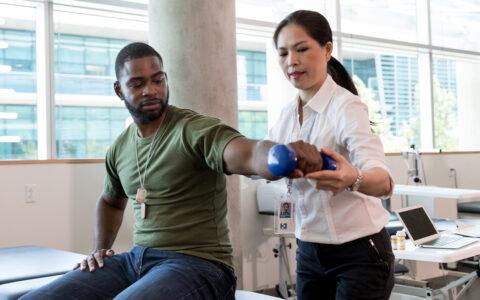While nerves that are severed by amputation have traditionally been left detached, some hand surgeons have begun connecting select nerves together at the time of amputation to reduce the likelihood of neuroma development, pain and phantom-limb symptoms.
Jed Maslow, M.D., co-director of the Limb Loss Clinic at Vanderbilt University Medical Center, who performs procedures to improve function and reduce pain in upper and lower extremity amputations, recently led a 10-year retrospective study on interdigital end-to-end coaptations.
“We started to address the nerves in partial hand amputations at the initial surgery to reduce their pain prophylactically,” Maslow said. “Coaptation is actually an old technique, but it had slipped off the radar. We brought it back and now, through this study, we have data to anchor the outcomes we have been seeing.”
Maslow says this is one of several techniques now being studied.
“One of the most exciting things we can do as nerve surgeons is learn from our patients about what is working and what is not working,” he said. “Each surgery is different – you are modifying and changing the algorithm, learning from your colleagues, learning from your patients, and adapting your technique as you go.”
Microsurgical Sewing
Coaptation is primarily offered to people who have a ray amputation or other palm-level amputation where the entire base of the finger is removed, “though it can be performed out to the tip of the finger,” Maslow said. Maslow and Vanderbilt colleague Mihir Desai, M.D. perform between 20 and 30 of these surgeries a year.
“Some of these surgical techniques can increase the capabilities of hand prosthetics by up to fivefold.”
“This is just one technique to treat nerve pain in an amputated part,” Maslow said. “It’s a pretty straightforward concept but requires a bit of microsurgical skill. Some of these surgical techniques can increase the capabilities of hand prosthetics by up to fivefold by multiplying the number of signals available to power them.”
Proof of Pain Avoidance
Maslow’s recent study included 54 patients with 289 affected nerves. The patients all underwent hand or digital amputation between 2010 and 2020. Thirteen of the patients underwent end-to-end coaptation nerve procedures on 78 nerves.
The researchers found significant differences in post-amputation pain and limb use between patients who did and did not undergo coaptation.
Specifically, the coaptation group presented about half the number of incidences of postoperative neuroma. None of the coaptation patients reported persistent pain in the affected area at final follow-up, versus 11.8 percent of those who had no coaptation. Patients in the coaptation group also had significantly lower rates of depression.
“For some of the patients that developed what was thought to be a neuroma early on, no long-term symptoms persisted,” Maslow said.
Targeted Muscle Reinnervation
Maslow and Desai are now researching patients with below-the-knee amputations to see which surgical techniques help relieve post-amputation pain and mobility. One technique, targeted muscle reinnervation (TMR), involves rerouting severed nerves into amputated muscles.
“Today, we have much improved functional outcomes with prostheses, and TMR may be improving more than just pain after surgery,” Maslow said. “If these nerve endings don’t go anywhere, they are kind of like live wires sparking and causing pain. By rerouting them into the calf muscles, it calms the nerve signal down, because you have given them somewhere to go and something to do.”
Maslow and Desai are currently working on a study to see if TMR might shorten post-surgical time to ambulation with prosthetic wear.
“We think TMR helps speed things – in part because of improved proprioception – and also through reducing postoperative pain,” Maslow said.
Beyond Corporeal Pain
Attending to physical pain is only part of the Vanderbilt Limb Loss Clinic’s mission.
“The trauma these patients have experienced encompasses much more than losing a limb,” Maslow said. “There is a lot of mental recovery that needs to take place as well. You go through all the same stages of grief that you do when you lose a close family member.”
The staff at the clinic work with patients to manage this loss, including the change in lifestyle, family and work relationships.
“You go through all the same stages of grief that you do when you lose a close family member.”
“These injuries are life-changing, but not life-ending.” Maslow said. “I have patients that refuse to look at their limb months after their amputation. These patients deserve a little extra time from us and more comprehensive care.”
To offer holistic help, the clinic provides social workers who help to coordinate mental health resources when indicated.




